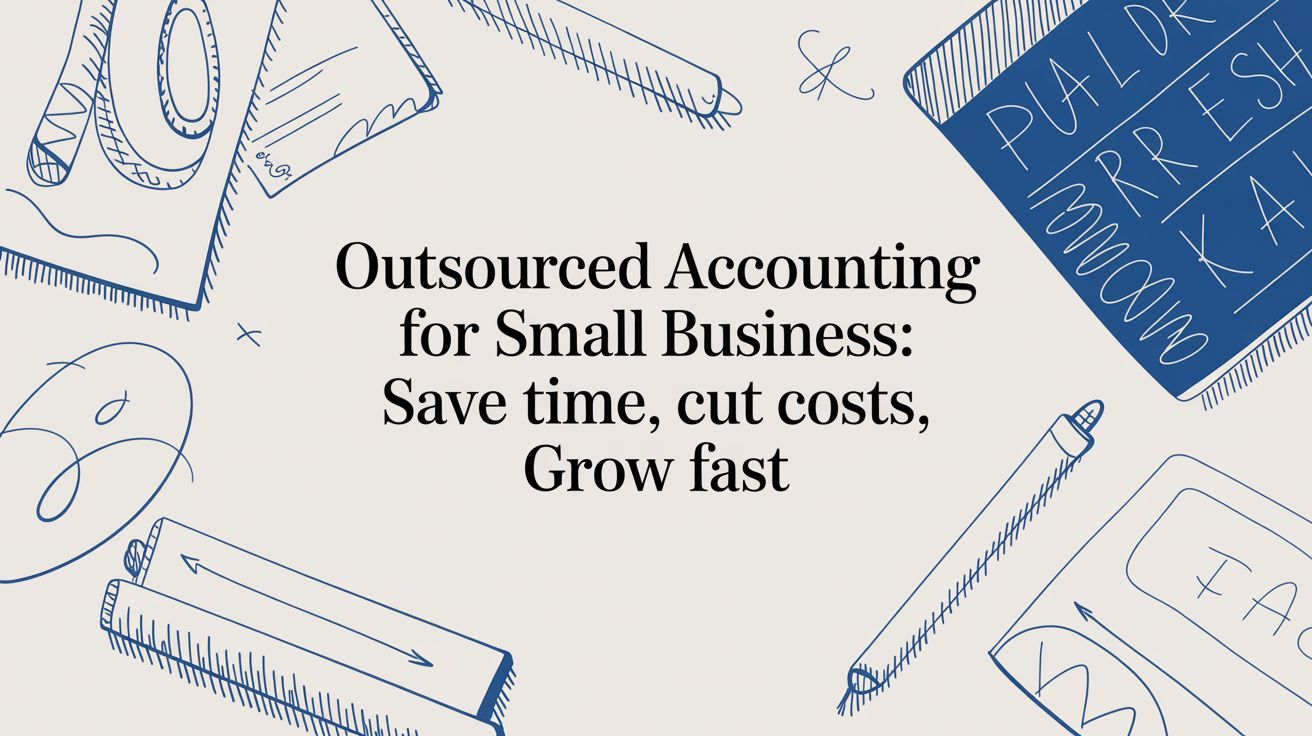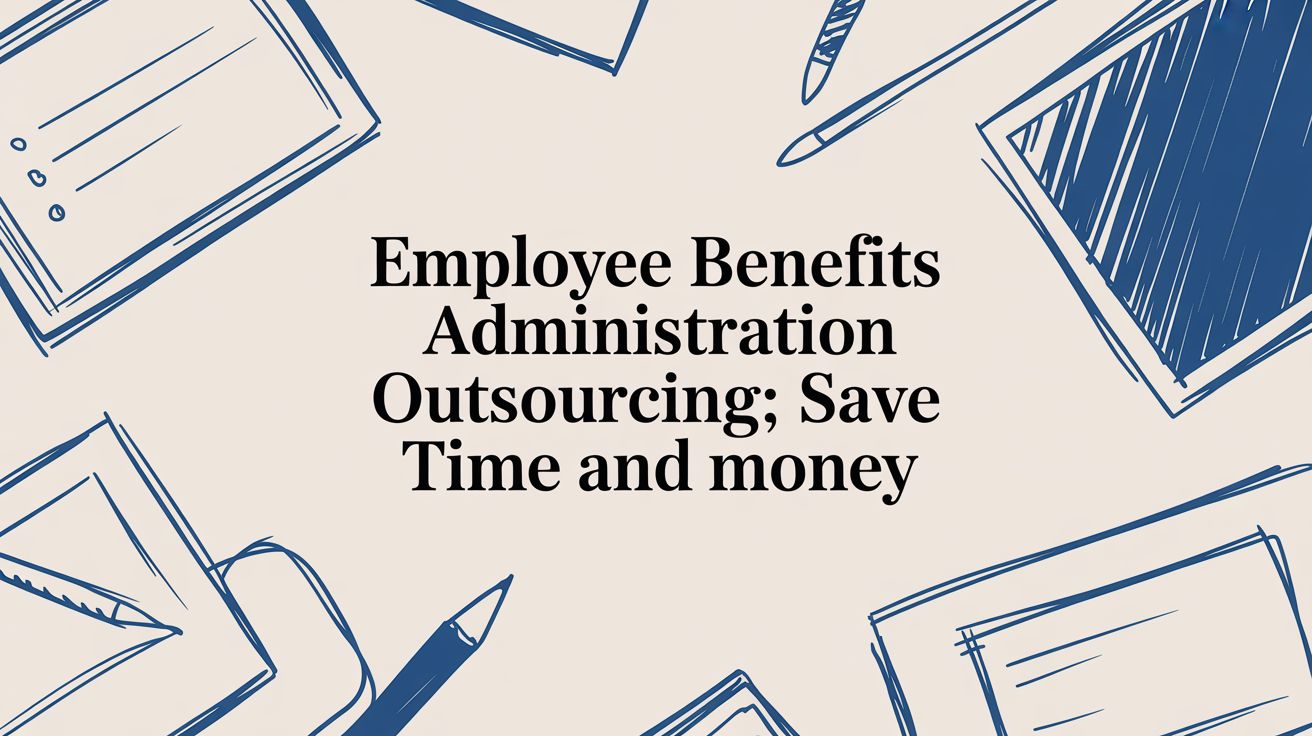
Your Essential Credit Memo Sample and Guide
A credit memo sample is more than just a template; it’s your go-to tool for correcting an invoice after it’s already been sent. Think of it as an official “oops” button for your billing. It lets you fix an overcharge, offer a goodwill credit, or adjust for a change in project scope, all without messing up your original financial records.
What Is a Credit Memo and When Do You Need One?

Let’s cut through the accounting jargon. A credit memo, which you might also hear called a credit note, is a formal document you send to a client to reduce how much they owe you. This isn’t the same as a refund, where cash changes hands. Instead, a credit memo adjusts their outstanding balance, leaving a credit on their account that can be applied to other invoices or wipe out the amount due on the current one.
This document is absolutely critical for keeping your financial records clean and accurate. In accounting, you can’t just hit delete on an invoice once it’s out the door. Doing so breaks the sequential numbering and can cause major headaches during an audit. The credit memo is the official counter-entry that keeps your books balanced and transparent. You can dive deeper into these distinctions in our guide on the difference between a receipt and an invoice.
Common Scenarios for Service Businesses
If you run a service-based business, you’ll find that your reasons for issuing a credit memo look a bit different from a retailer dealing with returned goods. You’re not handling damaged products; you’re dealing with billable hours, project deliverables, and client satisfaction.
Here are a few real-world situations I see all the time where a credit memo is the perfect solution:
- Billing Errors and Overcharges: It happens. Maybe you accidentally billed a client for 20 hours of consulting work instead of the 15 they actually used. A credit memo for the value of those five hours corrects the invoice cleanly.
- Goodwill Gestures: A project deadline slipped because of an internal hiccup, causing a minor inconvenience for your client. Issuing a small credit—even just 5-10% of the invoice total—is a professional nod that acknowledges the mistake and helps maintain a great relationship.
- Reduced Project Scope: The client signed on for a three-part marketing campaign, but halfway through, you both agree to scrap the third part. You’ll need a credit memo to adjust the original invoice to reflect only the work that was completed.
- Applying a Prepayment or Deposit: Sometimes a client’s deposit doesn’t get properly deducted from the final invoice. A credit memo is the simplest way to fix the balance and show the payment was accounted for.
By getting comfortable with these common triggers, you can handle billing adjustments professionally, keep your financial records straight, and manage your client accounts with confidence.
The Anatomy of a Professional Credit Memo

A vague or incomplete credit memo can cause more headaches than it solves. We’ve all seen them—the ones that lead to a dozen follow-up emails and leave bookkeepers scratching their heads.
To be effective, the document needs to tell the whole story of the adjustment. Think of it as a clear, standalone record. If your client or accountant looks at it six months from now, they should understand exactly what happened without digging through old conversations.
Essential Header Information
First things first, you need to clearly identify the document. This isn’t just a formality; it’s crucial for professional record-keeping. Start with a bold heading right at the top: “Credit Memo” or “Credit Note.” Leave no room for confusion.
From there, include these key identifiers:
- Your Company Details: Your business name, address, phone number, and email. It reinforces your brand and makes you easy to reach.
- Client Information: The client’s full business name and address, making sure it perfectly matches the details on the original invoice.
- Dates and Numbers: The document needs its own unique credit memo number for tracking and an issue date. Most importantly, it must reference the original invoice number it’s connected to. That link is the single most critical piece of the puzzle for clean accounting.
Without that original invoice number, your bookkeeper is left playing detective. This one small detail saves a surprising amount of administrative time and prevents costly errors.
The Core Details of the Credit
This is where you explain the “what” and “why” of the credit. A clear breakdown of the services or charges being adjusted is non-negotiable.
Don’t just issue a lump-sum credit. If you overbilled for “Consulting Hours” and “Project Management,” list them as separate line items. Just like on an invoice, each line should show the quantity, a brief description, the unit price, and the total credit for that item. This level of detail provides complete transparency.
After the itemized list, add a simple, clear reason for the credit. A short line like “Credit for overbilled project management hours” or “Goodwill credit for delayed project launch” is all you need.
Pro Tip: Keep the language in the “Reason for Credit” section neutral and professional. State the facts without getting emotional or placing blame. The goal is documentation, not a detailed apology in a financial document.
Finally, the memo needs a clear total. Add up all the line-item credits to show a subtotal, list any applicable sales tax that’s also being credited, and present a bold Total Credit amount. This is the number that hits the client’s account balance, making it arguably the most important figure on the page.
To make sure you don’t miss anything, here’s a quick checklist of the information every credit memo should include.
Key Information for Your Credit Memo
| Component | Purpose | Example |
|---|---|---|
| Document Title | Clearly identifies the document’s purpose. | “Credit Memo” or “Credit Note“ |
| Your Company Info | Your business name, address, and contact details. | “ABC Consulting, 123 Main St, Anytown, USA” |
| Client Info | Your client’s full name and address. | “XYZ Corp, 456 Oak Ave, Sometown, USA” |
| Credit Memo Number | A unique identifier for tracking. | “CM-1052” |
| Issue Date | The date the credit memo was created. | “October 26, 2023” |
| Original Invoice # | Links the credit to a specific transaction. | “Original Invoice #: INV-2023-087” |
| Itemized List | Details the specific items/services being credited. | “Project Management – 5 hours @ $100/hr” |
| Reason for Credit | Briefly explains why the credit is being issued. | “Service overcharge on original invoice.” |
| Subtotal | The total credit amount before any tax adjustments. | “$500.00” |
| Tax Adjustments | Credits back any sales tax from the original invoice. | “Sales Tax (8%) Credited: -$40.00” |
| Total Credit | The final, total amount to be credited to the account. | “Total Credit: $540.00“ |
By treating your credit memo like this essential checklist, you ensure every document you send is professional, clear, and ready for your books.
Grab Your Service-Based Credit Memo Samples
A quick search for credit memo templates usually lands you with a generic document built for retail. It’s full of fields for returned goods, SKUs, and restocking fees—all things that don’t quite fit a service business.
Your world isn’t about damaged products. It’s about correcting billable hours, making good on a service-level agreement (SLA), or adjusting for a project scope change. Trying to shoehorn those situations into a retail template is frustrating and looks unprofessional.
That’s why a one-size-fits-all approach just doesn’t cut it. You need a credit memo sample built for the nuances of service-based work. We’ve put together three distinct, downloadable templates to handle the real-world scenarios you actually run into, so you can stop wrestling with documents that don’t make sense for your business.
Specialized Templates for Common Service Scenarios
Instead of one generic file, we’re giving you a focused toolkit. Each template comes in Word, Excel, and PDF formats, so you can grab the one that fits right into your existing workflow. Just pick the scenario that matches your current situation, download the files, and pop in your company’s details.
These aren’t just blank forms; they’re structured to guide you.
- Consulting Overcharge Correction: This one is perfect for when you’ve accidentally overbilled for hours or miscalculated a rate. It has clear line items for adjusting hours or service fees, making the correction totally transparent for your client.
- SLA or Project Milestone Credit: Grab this sample when you need to issue a credit for not hitting a specific performance metric or project deadline. It includes a specific section to explain the reason, tying the credit directly back to your service agreement.
- Pre-Payment or Deposit Adjustment: This version is designed to cleanly apply a client’s deposit to their final bill, especially if it was missed on the initial invoice. It helps you true up the account balance without the confusion of a new, separate invoice.
Pro Tip: Using a template built for your specific situation sends a message of professionalism and clarity. It shows the client you have a solid process for handling corrections, which builds far more trust than a generic document you hastily modified.
How to Use Your Downloadable Credit Memo Sample
Once you’ve downloaded the right template, getting it ready is simple. The most important fields are clearly marked, and your main goal is to create a perfect link back to the original invoice.
First, get the basics down:
- Your company’s name and contact info.
- Your client’s full name and address—make sure it’s an exact match to what’s on the original invoice.
- The issue date and a unique credit memo number (something like CM-2024-015 works great).
Second, and this is the most critical part, you absolutely must enter the original invoice number. This is the non-negotiable piece of the puzzle that connects the credit to a specific transaction in your accounting system. Without it, you’re creating a reconciliation headache for yourself or your bookkeeper down the road.
Finally, adjust the line items to show the exact credit amount and add a short, professional reason for it. You don’t need a long-winded apology; a simple “To correct overbilled project hours” is all you need. The goal of this document is to be a clear, concise financial record. With these templates, you have exactly what you need to create one in just a few minutes.
How to Correctly Record a Credit Memo
Sending out a professional-looking credit memo is a great start, but it’s only half the job. If you don’t get the bookkeeping right on the back end, you’re setting yourself up for a real headache. Messy books, skewed financial reports, and a totally warped view of your company’s revenue are almost guaranteed.
https://www.youtube.com/embed/d6UOHktzgvA
When you record it properly, the credit memo becomes a powerful tool for financial clarity. It keeps your Accounts Receivable (A/R) clean, ensuring client balances are always accurate. More importantly, it correctly reduces your recognized revenue, which is absolutely critical for a true picture of your profit and loss. Getting this wrong means you’re likely overstating your income and creating reconciliation nightmares for your future self.
The Accounting Behind a Credit Memo
At its core, a credit memo is just a journal entry that reverses part of an original sale. This is a fundamental concept in the double-entry system, where every financial move you make has an equal and opposite reaction, affecting at least two accounts.
If you need a quick refresher on this, our post on double-entry bookkeeping explained is a great place to start.
When you post a credit memo, two main accounts get adjusted:
- Accounts Receivable (A/R): This is where you track all the money clients owe you. Since the memo lowers the amount a client has to pay, you will credit your A/R account. This directly decreases their outstanding balance.
- Sales or Service Revenue: This account tracks the income your business brings in. Because you’re effectively canceling out a piece of a sale, you will debit either your main Sales Revenue account or a contra-revenue account like “Sales Returns and Allowances.” This lowers your total reported revenue.
Key Takeaway: The journal entry for a credit memo reduces both your assets (what’s owed to you in A/R) and your revenue (what you’ve earned). This is what keeps your books perfectly balanced and your financial statements accurate.
Understanding this dual impact is crucial. It’s not just about doing a favor for a client; it’s about making sure your company’s financial records reflect reality.
And if you’re using our templates, the process couldn’t be simpler.

This workflow shows just how easy it is to find the right template, download it, and tweak it for your specific needs, getting you up and running in no time.
Recording a Credit Memo in QuickBooks Online
Thankfully, for most of us using modern accounting software like QuickBooks Online, these journal entries happen automatically in the background. It’s a massive time-saver. Instead of manually plugging in debits and credits, you just follow a straightforward workflow.
Here’s what that process typically looks like in QuickBooks:
- First, you’ll navigate to the + New button. Under the “Customers” column, simply select Credit Memo.
- Next, choose the customer from your list, and QuickBooks will fill in their details. The key here is to enter the exact product or service you’re crediting, along with the quantity and rate, so it matches the original invoice you’re adjusting.
- Once you save it, QuickBooks will ask if you want to apply the credit to an existing invoice. This is the magic step that connects the credit directly to that client’s outstanding balance.
By linking the credit memo right to the invoice, you ensure the client’s balance is updated instantly and accurately in your A/R. This automated process is a lifesaver, preventing the kind of human error that plagues manual journal entries and keeping your financial data completely reliable.
Managing Client Credits Without Losing Trust

When you issue a credit memo, you’re doing more than just fixing a number in your books. Each credit is a critical moment in your client relationship. Handled poorly, it can cause damage. But when you get it right, it can actually make the relationship stronger.
The best approach is always a proactive one. If you wait for a client to find a billing mistake, you’re immediately on the back foot.
But if you spot an error on your end and address it before they even see it? That shows real integrity. This simple act of transparency can turn a potential negative into a huge trust-building moment.
Think of it this way: a credit memo isn’t an admission of failure. It’s proof of your commitment to being fair and accurate. Owning a mistake shows clients you value them more than the dollar amount in dispute.
Develop a Clear Internal Policy
You can’t afford to figure out your credit process on the fly. You need a clear, internal policy for when and how credit memos get issued. This takes the guesswork out of the equation and ensures every situation is handled consistently.
Your internal guidelines should nail down a few key points:
- Approval Thresholds: Who has the authority to issue a credit? Maybe credits over $500 need a manager’s sign-off.
- Common Scenarios: Create standard operating procedures for things that might happen again, like overbilling for hours or issuing a goodwill credit for a missed deadline.
- Communication Protocol: Map out exactly how to tell the client. A short, professional email that explains what happened and includes the credit memo is usually the best way to go.
Having a documented process means every client gets the same professional treatment, which reinforces their confidence in your business. It also makes life easier for your team by creating a predictable workflow, which is a cornerstone of solid accounts receivable best practices.
Turn Credit Data into Business Insights
Don’t just file your credit memos away and forget about them. Each one tells a story and can point to bigger, systemic issues in your operations. By tracking the reasons for your credits over time, you can spot patterns you’d otherwise miss.
For instance, are you constantly issuing credits for overbilled project management hours? That could signal a problem with how you scope projects or track time.
Are you frequently giving goodwill credits for blown deadlines? It might be time to take a hard look at your project management workflow.
When you analyze this data, your credit memo transforms from a simple accounting document into a powerful diagnostic tool. It helps you find the weak spots in your service delivery or billing processes. Fixing these root causes won’t just reduce future credits—it will improve your service quality and make your clients happier.
Common Questions About Credit Memos
Even with a solid process in place, tricky situations are bound to pop up. When you first start using credit memos, a few questions always seem to surface. Let’s walk through the most common ones we hear from our clients.
Credit Memo vs. Refund: What’s the Difference?
This is easily the biggest point of confusion. A credit memo and a refund are not interchangeable, and getting them right is critical for clean, accurate books.
- A credit memo is an internal accounting adjustment. It reduces what a customer owes you, leaving a credit on their account that they can use against future invoices. The money never leaves your business; you’re simply adjusting your accounts receivable.
- A refund is exactly what it sounds like: a cash-out transaction. You are physically sending money back to the customer. This hits your cash flow directly and is recorded on your cash flow statement.
For most B2B service businesses, issuing a credit memo is the much cleaner and preferred option. It keeps the cash in-house and maintains the client relationship for future work.
Do I Always Need an Original Invoice Number on a Credit Memo?
While it’s a strong best practice, there are very rare exceptions. You might, for instance, issue a small “goodwill” credit to a long-term client as a thank you or to smooth over a minor issue that wasn’t tied to one specific invoice. It happens.
That said, for 99% of the credit memos you issue, you absolutely need to link it back to the original invoice. This creates a crystal-clear audit trail and prevents any confusion down the line for both you and your client.
How Long Should I Keep Credit Memo Records?
Simple rule of thumb: keep your credit memos for as long as you keep all your other important financial documents, like invoices and tax filings.
In the United States, the IRS generally recommends holding onto business records for at least seven years. This ensures you have a complete financial history for every client transaction, which is invaluable if you ever face an audit.
At Steingard Financial, we transform messy books into a source of clarity and confidence. If you’re tired of handling complex bookkeeping and payroll on your own, see how our expert team can build a scalable back office for your service business. Learn more about our services.






